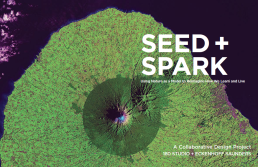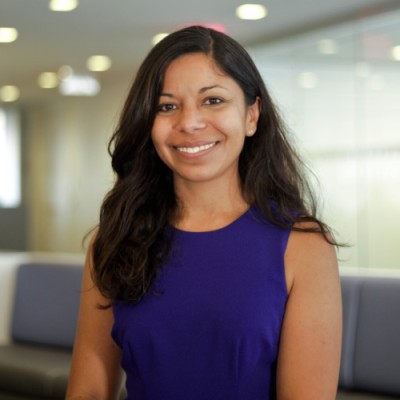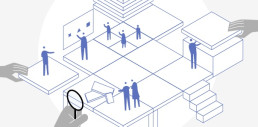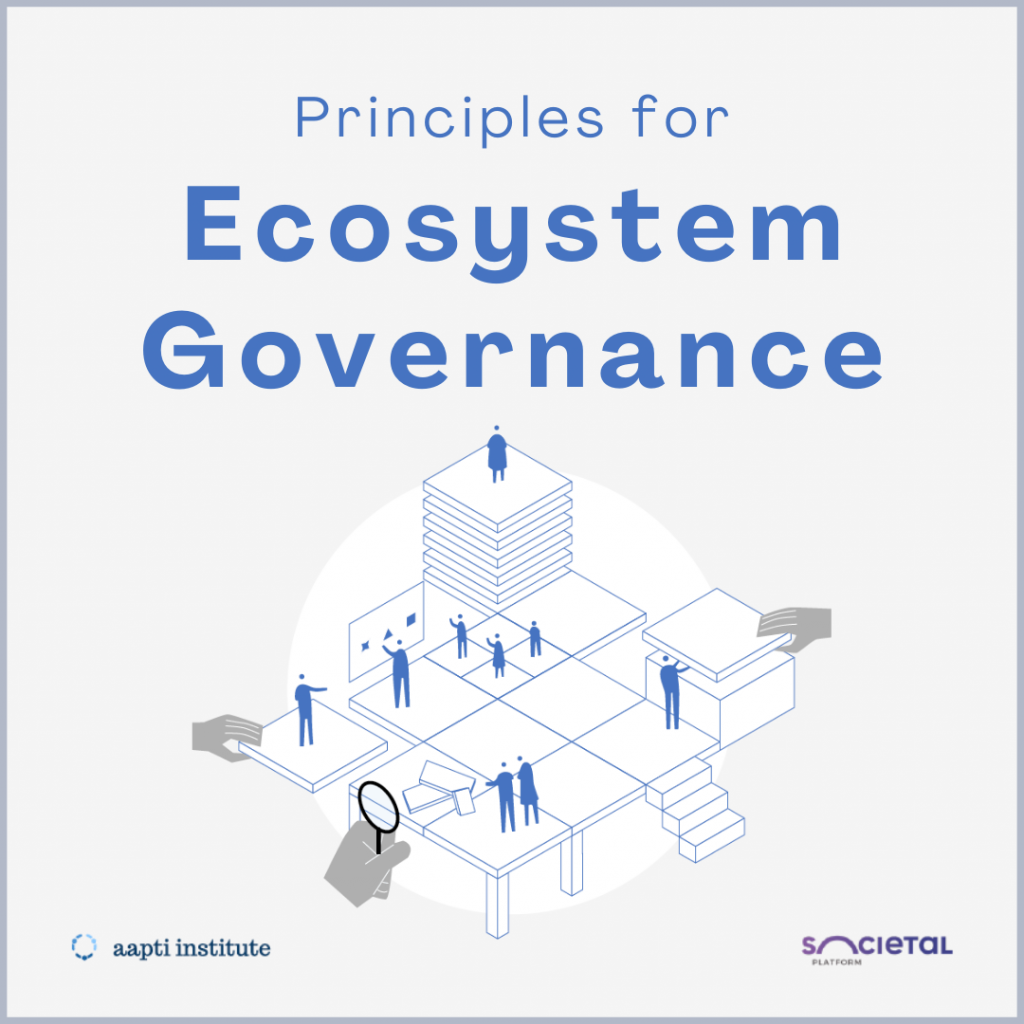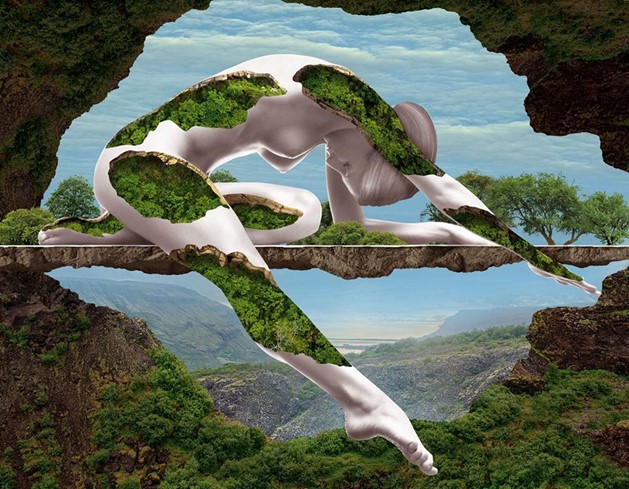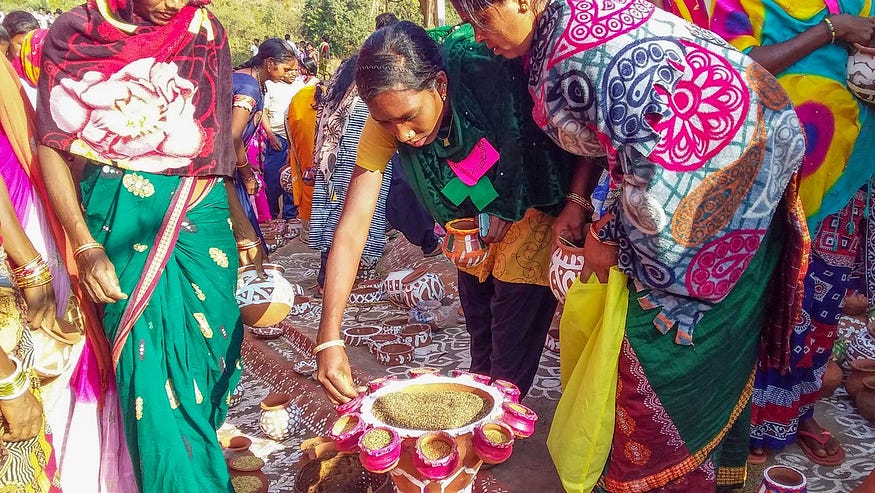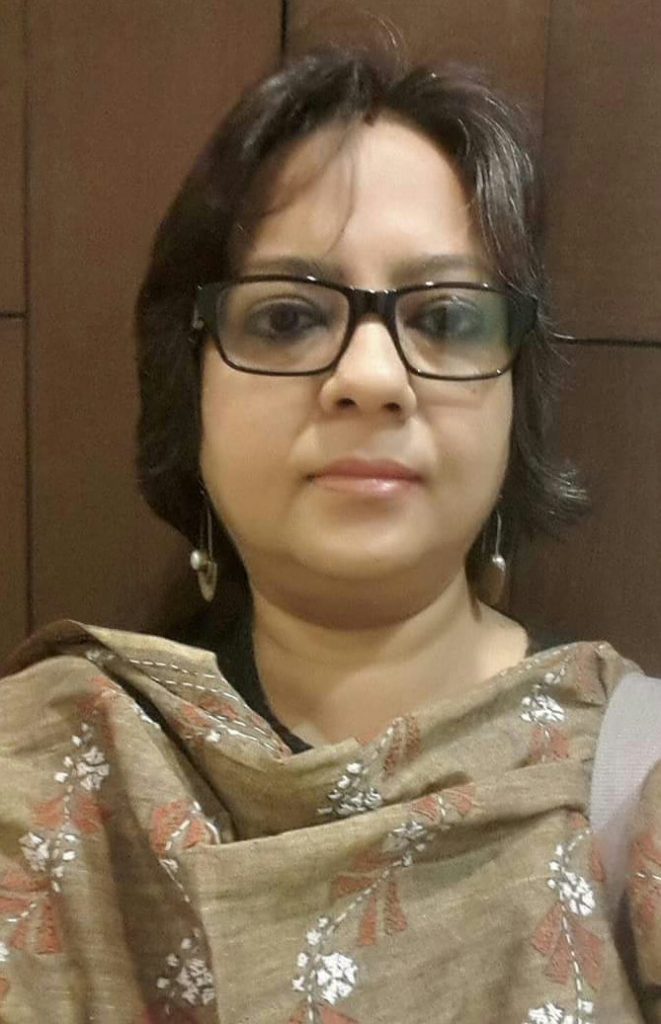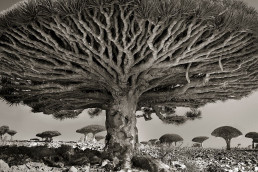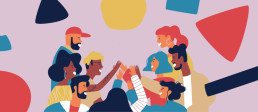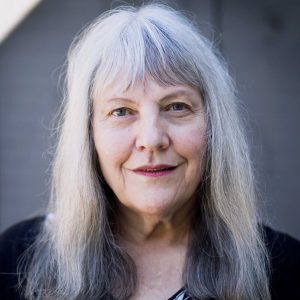event: Evolve 2021
Evolve 2021 is a collaborative gathering of people from around the world who want to come together and learn from each other ways that we can all make a difference in the world, starting with ourselves. Close to 80 conveners will hold space for exploring ideas, sharing practices that are working, and raising topics that don't get talked about all the time. Three days [ Oct 20 - 22 ] of amazing learning from both founders in the field and emerging practitioners, as well as non profit leaders and social justice advocates.
This is a conference you won't want to miss. It's a difference maker, acknowledging that today's world needs more people coming together, sharing their similarities and working out their differences. Why? Because we need to make changes to thrive! And those changes can only happen if we better understand one another and collaborate to make our world a better place to live ... for everyone. Change begins with each of us - each of us taking the steps we can. And to do that, we need to know "how." Evolve 2021 will put us in touch with one another so we can collaboratively work together to find that "how."
A pipe dream? Maybe ... but only if we choose not to take up the challenges and take advantage of the opportunities. Evolve2021 is a virtual conference and while virtual conferences have their disadvantages, they have one huge AD-vantage. It allows us to attract the best and the brightest from all over the world, keep costs lower, and include more people from more places and more backgrounds. Our presenters are excited to be a part of this unique gathering. Hear what Wendy Edmonds and Davitta Ealy or Fred Miller and Matt Minihan have to say about being involved with Evolve 2021. We believe that you will be excited too, and we know that our community can solve more issues when we have more hands making the work happen. Evolve gets better with every person who signs up to be a part of it.
We know that people's financial situations are different, and that COVID and 2020 have affected us all. The team at Evolve has made a number of efforts to mitigate registration costs, including offering half price entrance in exchange for moderating two or more 1-hour sessions. It's a great way to be involved, get to know some of the conveners, and learn along the way. If you really want to be a part of this gathering but are unable to meet moderator or other pricing, contact the team to see what we can do for you.
For information on how to register for this global gathering, check out our website: www.evolve4change.com.
You can also visit the Evolve 2021 LinkedIn page
Seed + Spark
Sam Chaltain produced the wonderful book Seed + Spark as part of a collaboration between 180 STUDIO and ECKENHOFF SAUNDERS. This is a gorgeous and magical tour, one that I encourage you to explore. I found so much new information here and found the many stories they included to illustrate each chapter’s theme inspiring and insightful.
Sam is offering the book to us at no cost in pdf format, but you may want to splurge on a paper copy - it’s that wonderful!





The Table of Contents reveals the breadth of topics covered:
The authors’ preface outlines the path they will take:
You can download the pdf of the book HERE.
THE WORLD IS CHANGING. WHAT IS IT SHIFTING FROM, AND TO? 180 IS A GLOBAL DESIGN STUDIO DEDICATED TO EXPLORING THIS QUESTION.
We design human-centered environments and curate stories that advance our understanding of the future of learning -- and, by extension, the future of humanity.
Eckenhoff Saunders is a Chicago-based, architecture, planning and interior design firm. Our work is defined by innovative problem solving, client-centered service, technical expertise and pragmatic experience.
We collaborate with diverse organizations in the healthcare, educational, hospitality, non-profit, commercial, financial and industrial markets to develop meaningful design solutions that enhance the lives of those who experience our buildings.
Creating a supportive network culture
Collective Mind hosts regular Community Conversations with our global learning community. These sessions create space for network professionals to connect, share experiences, and cultivate solutions to common problems experienced by networks.
Our June 16th Community Conversation welcomed Sé Franklin, a coordinator from MenEngage Europe, to share his network’s experiences around developing a core set of values and code of conduct while evolving their network culture in response to the global pandemic. MenEngage Europe is a regional network of MenEngage, a global alliance working toward advancing gender justice, human rights, and social justice and provides a collective voice to engage men and boys in gender equality and gender justice.

Highlights from the conversation
A network’s culture is the shared values, norms, attitudes, and practices of the individuals’ and groups’ behaviors that influence their interactions. The culture should maintain the network’s shared purpose and harness the nature of network practice — one of transparency, inclusivity, and collaboration — by cultivating shared norms and practices in ways that establish constructive dynamics across the network. Yet, much like our Community Conversation on equity articulated, establishing and holding each other accountable to shared norms comes with challenges. Defining, discussing, and modeling network culture can be uncomfortable, complex, and sometimes by necessity, dynamic. However, as highlighted by our co-host, it can also be rewarding and can create brave spaces that ultimately strengthen the network.
Sé discussed MenEngage’s “house rules” — a set of beliefs, values, and code of conduct that its members subscribe to and that can be used to hold each other to account, both in their work and, by extension, how they individually engage in the world. He also shared informal aspects of the network’s operating philosophies and how they have evolved over time. What emerged from the conversation was a number of important and necessary factors that go into holding up a networks’ culture.
When cultivating a network culture, one of the most important aspects is to support and encourage people to be real, present, and accountable and demonstrate this in practice. Many networks and network members are engaged in work that goes against the mainstream while also being geographically dispersed, contributing to a feeling of isolation. Network coordinators and managers can step in and build a ‘personal’ culture that provides care and support for members by creating spaces that feel safe, that acknowledge people’s struggles, and encourage people to be courageous. Alongside that is setting the expectation that participants in these spaces must also be prepared to challenge and be challenged, but to do so with care, sensitivity, and awareness.
Another theme that emerged was the necessity and benefit of network culture evolving and adapting to variable circumstances and becoming a place of care for members in the face of change. The move from in-person interactions to online engagement resulting from the pandemic can be viewed as a positive outcome for many networks, for example. In many cases, it enhanced access to and amongst members and created more supportive connections while also enabling people to engage from the comfort of their homes. A positive byproduct of this operating environment is having created a space in which participants can feel braver, more comfortable, and more reflective than they might have in person.
Just as with centering equity in networks, cultivating a network culture requires trust and the ability of network leaders to invest in efforts that will ultimately foster trust in its network relationships. During the pandemic, MenEngage initiated monthly check-ins centered on checking in on people’s well-being and listening to each other, while also using the time to reconnect with members, rethink the priorities of their canceled annual symposium, and discuss ways to model the culture they were trying to cultivate.
Network culture can be complex and manifest in different ways, as emphasized by our co-host. In some cases, a code of conduct can be documented and laid out as a formal set of rules. In other cases, aspects of the network culture take on a more informal shape, providing the flexibility to evolve under variable circumstances. In still another instance, accountability to a set of norms and attitudes can be linked to the network’s mission, for example, a formal commitment for MenEngage to be accountable to women-led feminist organizations. In other words, network culture is as complex as networks themselves, but a strong and intentional network culture that actively supports its members and maintains quality connections is necessary to harness the transformative power of networks.
Miss the session? View the recording here.
Thanks again to our co-host, Sé Franklin from MenEngage Europe!
Get involved
Have your own experiences with efforts to create a supportive network culture? Tell us about it in the comments below.
Join us for the next Community Conversation!
Or email Seema at seema@collectivemindglobal.org to co-host an upcoming session with us.
Originally published HERE
Featured image found HERE
Seema Patel has been working with mission-driven organizations and multi-stakeholder initiatives for more than 15 years - as a project manager, a volunteer, and an advisor. She has worked in the areas of domestic and global alternative energy, poverty alleviation, social and sustainable entrepreneurship, non-profit web strategy design, and U.S. government management consulting. In her work with Collective Mind, Seema specializes in network analysis, organizational design, knowledge management and learning, and operations.
PLEASE DONATE to help Network Weaver continue in it’s mission to offer free support and resources to networks worldwide.
Critical support for network leaders and managers
We could all use a little support, especially these days. At Collective Mind, we believe that we can best support network leaders and managers by providing them with evidence-based training and materials, and spaces in which they can connect and learn from one another. As the founder, my own personal experience of being a network manager was realizing early on that I didn’t understand the unique network environment and didn’t know how to do my job effectively. It sent me on a learning journey that started more than a decade ago and that now manifests in Collective Mind’s support to network leaders and managers. When network practitioners have the skills, tools, and approaches they need, they not only do their jobs well, they also make their networks more effective and impactful.
Collective Mind Academy is our latest professional development offering in the style of a semester-focused course. We’ll cover five critical topics over 10 weeks:
- Establishing your network’s shared purpose
Shared purpose is the visionary goal around which strategies are defined, people are mobilized, and activities are established and harmonized. We’ll consider how to set the scope of a network’s shared purpose, how it influences your membership, how to translate it into strategies, and more.
- Developing your network’s membership model
Along with shared purpose, membership is a foundational capacity of networks. We’ll consider the multiple components of your membership model including who your members are, the nature and size of your network’s membership, and criteria for membership as well as how to think about engagement, inclusion, and equity.
- Designing your network’s infrastructure
Network infrastructure is the structural design and components of a network, including externally visible structures and processes, that support collective action by members. We’ll consider how to structure your network to ensure key functions and roles including governance, management, and production of outputs and outcomes towards your network’s shared purpose.
- Building your network’s culture
Network culture is the network’s operating philosophy including the shared values, norms, attitudes, and practices of both individuals and groups. While often intangible, the network’s culture maintains the shared purpose and ensures ongoing collaboration. We’ll consider how to manage the range of dynamics that arise in a network (conflict, accountability, etc.) and how to foster effective collaboration.
- Embodying a network mindset
A network mindset recognizes, understands, and responds to the complexity of a network as well as appreciates the differences between a network and a traditional organization. A network mindset understands that we work through a network because the goal or challenge that we seek to address requires a complex set of stakeholders acting together. We’ll consider how to foster a network mindset within and across your network and how to embody it yourself.
Each topic will be covered during a two-week module through evidence-based readings, worksheets to reflect on your work, additional readings to reference as desired, and office hour sessions to access the expertise of both Collective Mind and your peers.
You can complete the course on the schedule and with the structure that is right for you. You can join the full Academy or pick and choose the modules most important to you. You can follow along with the course as we go, joining live office hour sessions, or you can review each topic on your own time accessing the materials and session recordings.
Whether you’re new to networks or a seasoned professional looking for new ideas and strategies, you will find the resources you need. For more details and to register, check out our website. We hope to see you there!
Collective Mind seeks to build the efficiency, effectiveness, and impact of networks and the people who work for and with them. We believe that the way to solve the world’s most complex problems is through collective action – and that networks, in the ways that they organize people and organizations around a shared purpose, are the fit-for-purpose organizational model to harness resources, views, strengths, and assets to achieve that shared purpose.
Principles For Ecosystem Governance
As we adopt Societal Platform Thinking towards working with the ecosystem to achieve the mission, there is a wide and diverse range of interactions that happen and generate value. Interactions that could be around programmes, solutions, infrastructure, and resources. Thus, it becomes important to establish governance mechanisms for balanced evolution of such interactions and their outcomes. Societal Platform partnered with Aapti Institute with the aim to articulate a set of principles that could guide in governing Societal Platforms. The attempt is to identify principles that account for societal values, and aspire to maximise societal impact with a focus on the agency of individuals and institutions.
The report and the included principles have emerged from desk research along with a set of interviews and a brief round table with a few societal missions.
Key Takeaways:
- Bias interactions to deliver impact by identifying and indexing all processes that deliver higher impact.
- Embed accountability by ensuring clearly articulated responsibilities indexed for context and establishing accessible grievance redressal processes.
- Design for evolvability by ensuring that governance processes adapt to emerging challenges and opportunities for the platform to be resilient and sustainable.
![]() Report: Principles for Platform Governance
Report: Principles for Platform Governance
The principles articulated in this document aim to provide a framework for thinking about infusing societal values into governance.
![]() Presentation: Ecosystem Governance Principles
Presentation: Ecosystem Governance Principles
In this presentation, you will find the 11 principles with a ‘pillar and lever’ framework. These principles seek to embed societal values - drawn from constitutionalism, democratic values and individual liberties.
Originally published HERE at Societal Platform
DOWNLOAD the package of all three resources HERE
Societal Platform is a community of curators, catalysts, and network weavers. They pool their individual strengths and channel their collective imagination to enable social change leaders to advance their missions.
PLEASE DONATE to help Network Weaver continue in it’s mission to offer free support and resources to networks worldwide.
Reimagining a Regenerative Future — Part 3
Creating narratives that are harbingers of life-affirming paradigm shifts
This is an extraordinary time full of vital, transformative movements that could not be foreseen. It’s also a nightmarish time. Full engagement requires the ability to perceive both. ~Rebecca Solnit quoted in Brainpickings
We live in a profoundly damaged world, a wounded and a bleeding planet. The ‘great acceleration’ of the Anthropocene founded on the human hubris of controlling and subduing nature, infinite growth driven by endless extraction and ecocide, and a deeply colonial and racist mindset has brought us to this cusp of simultaneous systems collapse — of economies, polities, societies, communities, ethics, values, and religions.
Polarization, fracture, and fragmentation are manifesting in all their destructive dimensions within and between nation-states. The ostensibly boundary-less, ubiquitously connected globalized world is erecting boundaries within national borders — between its own citizens, driving neighbors against neighbors, turning citizens into vigilantes. Growing injustice and inequality coupled with social, racial, communal, and religious rifts are tearing apart the fabric of most nations.
The richest 1% owns half the world’s wealth. Billionaires wealth rose an approximate of $10.2 trillion amid Covid crisis. “While the full impact of the COVID-19 pandemic is unknown, the World Bank estimates that an additional 88 million to 115 million people will fall into extreme poverty in 2020, with the total rising to as many as 150 million by 2021.” Mega-corporations like Amazon, owned by the richest man in the world, are known for its bruising work environment. Rich and powerful nations are blocking waivers for Covid-19 vaccine patent rights thus denying vaccination to millions in the face of a global pandemic. Global North nations are destroying less powerful nations for control over natural resources, cheap labor, and land. The cult of consumerism, accumulation, and excess are devastating the planet. Fundamentalism and authoritarianism are on the rise across the globe. All for the sake of power, profit, and privilege.
Is it any wonder that this pathologically unequal world is falling to pieces? The enforcement of deregulated capitalism with its associate free market ideologies have crashed the world’s systems — economically and ecologically. The imposition of structural adjustment programs on the global South countries have effectively destroyed the development that they had sought to make post colonialism.
A combination of austerity, privatization, and deregulation have destroyed the basic infrastructure in most countries. Corporations, freed of all regulations and responsibilities, are recklessly destroying the environment, scouring the planet for the most exploitable labor and that last drop of oil with ever more invasive and extractive technology. The world is literally going to hell in a handbasket.

It is easy to imagine that the world is being run by a handful of megalomaniacs and plutocrats. The underlying narratives of capitalism, free-market, globalization, and growth have created the fertile conditions and space for the rise of such totalitarianism. One wonders what happened to the story of development and progress for all. However, the truth is that the world fell prey to the dangers of a single story.
Since 1980, the global economy has grown by 380%, but the number of people living in poverty on less than $5 (£3.20) a day has increased by more than 1.1 billion. That’s 17 times the population of Britain. So much for the trickle-down effect. ~Jason Hickel, Forget ‘developing’ poor countries, it’s time to ‘de-develop’ rich countries, 2015
If we peel off the layers and go back in history, we can trace the roots of the narrative running the show for the past 500 years to imperialism and colonialism, Enlightenment and the Industrial Revolution, rise of capitalism and the free market. Today’s ‘universalized’ and homogenized story of development and growth was a western concoction imposed on the rest of the world as a part of the imperialist project of colonization and continued through globalization and neo-colonialism. The rest of humanity was forced to forfeit and forget other ways of being on and relating with this planet and all sentient beings.
However, as our civilization faces imminent collapse and the impending existential crisis of the sixth mass extinction, it is becoming clear that we must reclaim, re-member, and revive those lost and abandoned ways. For centuries, the indigenous people have been turned into fugitives in their own land in the name of development, rendered homeless in the name of growth, brutally persecuted when they claimed what was rightfully theirs.
Even as we teeter on the edge of unprecedented ecological disaster, it is worth remembering that while comprising less than 5% of the world’s population, indigenous people protect 80% of global biodiversity. One of the earliest forest conservation movement in India took place in 1973. Called the Chipko Movement, it saw primarily women hugging the trees to prevent them from being felled for logging. Sunderlal Bahuguna, a Gandhian activist, brought this nonviolent movement to the world’s attention with the rallying cry, “Ecology is the permanent economy.” This was 1973.
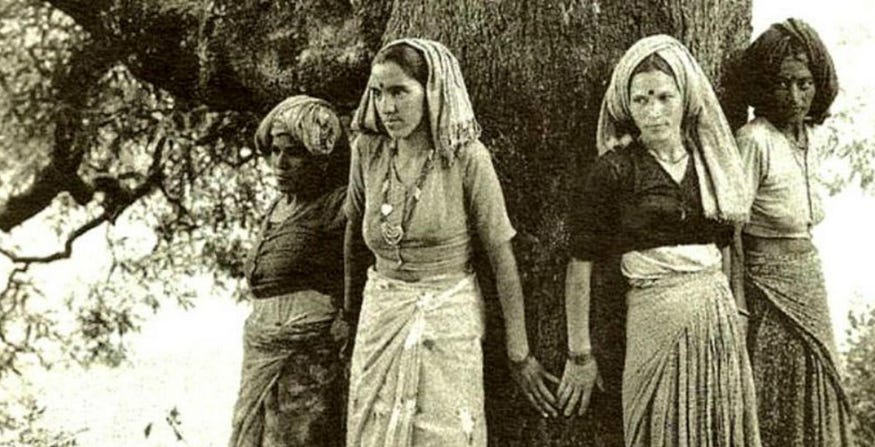
The single unifying issue facing Indigenous Peoples everywhere is how to protect their territories and stop the “asset stripping” that robs them of their livelihoods and the foundation of their cultures. Without land and control of their assets, Indigenous Peoples are destined to remain the world’s poorest communities — with the worst health, highest mortality rate and shortest life span. ~The Indigenous Movement
We know that life thrives on diversity. Any forest ecosystem is a teeming hub of myriad visible and invisible life forms from magnificent old trees to the minutest of fungi to the mycorrhizal networks beneath the soil. Yet, the narrative of Eurocentric development has continuously sought to eliminate all forms of diversity — from different cosmologies to unique ontologies and epistemologies, from diverse forests and farms to different economies. It constantly tried to subsume varied ways of being, seeing, and living into its mega-narrative of western universalism, ironing out all uniqueness through brute force.
The hegemonic narrative emanating from a mechanistic, dualistic, utilitarian, hierarchical, and colonial view of life, enforced a distorted and superficial homogeneity in the name of efficiency, productivity, and development on all of civilization. It also imposed a fabricated classification of humanity that impacts billions to this day. The sole aim was and is the accumulation of power and capital by a few at the cost of billions.
Under this industrializing force, thriving forests gave way to mega-monocultures for the sake of agribusiness. Homes of critically endangered wildlife became vast palm oil plantations. Supply chains expanded across the globe stretching from China to Walmart’s doors. Local ecosystems and economies (in the global South) were brutally destroyed to open up international markets in the name of free trade, rendering millions homeless and helpless thus adding to the pool of cheap and disposable labor. Indigenous tribes were rendered homeless as their land was expropriated for mining, logging, and other ills.
The economic, political, and social systems originating from this narrative literally went about exploiting, expropriating, and extinguishing life. Because the founding narrative never valued the web of life with all its abundance and breathtaking beauty, interdependence and inherent intelligence, there were/are no qualms about snuffing it out.
The mindboggling annihilation we have wrought in the name of development is truly unbelievable. The saddest part is that it is not within human capacity to bring back extinct species, to rewild the coral reefs in all their magnificence and multihued diversity, to prevent wildfires from consuming forests and wildlife. We are ‘gambling with what is irreplaceable and precious,’ to use Naomi Klein’s words. But nature is resilient, generative, and autopoietic. Minus human-made destruction, life will assert herself. But for that, we need to let go of our old narrative and embrace a narrative that is regenerative and pluriversal. A narrative that pays homage to life and thus becomes that catalyst and cornerstone for creating structures and systems that are conducive to life.
The globetrotting pandemic ripped apart the façade of progress and development to reveal the papered-over brokenness of our current planetary systems; it also underscored our ineradicable interconnectedness and interdependence with all sentient beings on this planet. However, this seems to have gone unnoticed by those in power. They are once again busy trying to use the crisis to push through policies and programs that people would not accept during normal times.
Naomi Klein in The Shock Doctrine: “In moments of crisis, people are willing to hand over a great deal of power to anyone who claims to have a magic cure — whether the crisis is a financial meltdown or… a terrorist attack.” Those at the helm of world affairs today are being driven by their basest instincts geared towards profit, privilege, and power for a few. We are experiencing a global crisis of leadership, a crisis of conscience, and a crisis of consciousness. And these multiple crises are manifested in the economic, political, and social structures and processes at play today.
However, ordinary people are no longer buying the narrative. From students to farmers, from housewives to indigenous tribal members, they are out in the streets demanding their right to a just, meaningful, and dignified life. The past decade has, therefore, also become the decade of movements. From #OccupyWallStreet to #ExtinctionRebellion, from #FarmersProtest to #FridaysForFuture, from #BlackLivesMatter to #DemocracyforMyanmar. These lists of movements from 2020–2021 are telling a story of an emerging civilizational order vastly different from the old one. They are showing us that the old narrative of European male hegemony and the privilege of power is dead. Those benefitting from it will use every arsenal at their disposal to maintain the status quo, but the war is already lost.
We are experiencing the collapse of the current narrative in the face of global crises. And when narratives collapse, revolutions happen, new shoots of hope arise, new stories are created. And a new world order emerges. It is in our hands to reimagine our civilizational narrative. To throw off the yoke of the old order with its narrow Western worldview and co-create a pluriversal narrative — one that encompasses many cosmologies, ontologies, and epistemologies. A cultural meta-narrative that recognizes and respects the innumerable ways of being, seeing, sensing, and knowing of humans and other-than-humans. One that resonates with the astoundingly diverse and stunningly beautiful web of life. It is time to reimagine new narratives for a civilizational evolution that is life-sustaining.
The new narrative is already arising from the grassroots, from the fringes, and the margins. They are harbingers of the voices of people who have been marginalized and delegitimized for centuries — the blacks, the indigenous, the women, the farmers, the students, the activists, the transgenders. The bearers of this new narrative are the rebels, renegades, radicals, and revolutionaries — they are the visionaries and the imaginal cells of a future taking shape in the present.
They are the ones the status quo is most afraid of. No wonder the privileged are doing all in their power to quell, suppress, and oppress the rising tides of discontent and truth. From incarceration to outright killing, every gruesome and chilling action is being taken to keep the truth from bursting through the carefully erected, centuries-old veneers of deception, duplicity, and deceit.
Those in power are afraid. They have too much to lose after centuries of accumulation and grabbing. They cannot let go with grace. As Otto Scharmer wrote: “The image of the Ever Given — needing to unload its cargo in order to get unstuck — represents in a microcosm the collective impediment that rich countries and Western civilization embody today: holding on to stuff and refusing to share with those who are on the other side of the social divide.” This applies to all those who are benefitting from the status quo.
“By refusing to risk its way of life, by rejecting the idea that the powerful might have to sacrifice for the common good, it clings to a set of social arrangements that allow it to monopolize progress and then give symbolic scraps to the forsaken — many of whom wouldn’t need the scraps if the society were working right.” ~Anand Giridharadas, Winners Take All: The Elite Charade of Changing the World
Joanna Macy spoke about this period as the Great Turning — a transformational moment in human history — when the foundations of the Industrial Growth Society would finally totter and crumble, and a new Life Sustaining Society will arise. However, this new society will not be ushered in willingly by those benefitting from the old one. The shift will need to be envisioned and co-created by communities and collectives of individuals from all walks of life staking a claim to this planet and standing up for the right of all sentient beings.
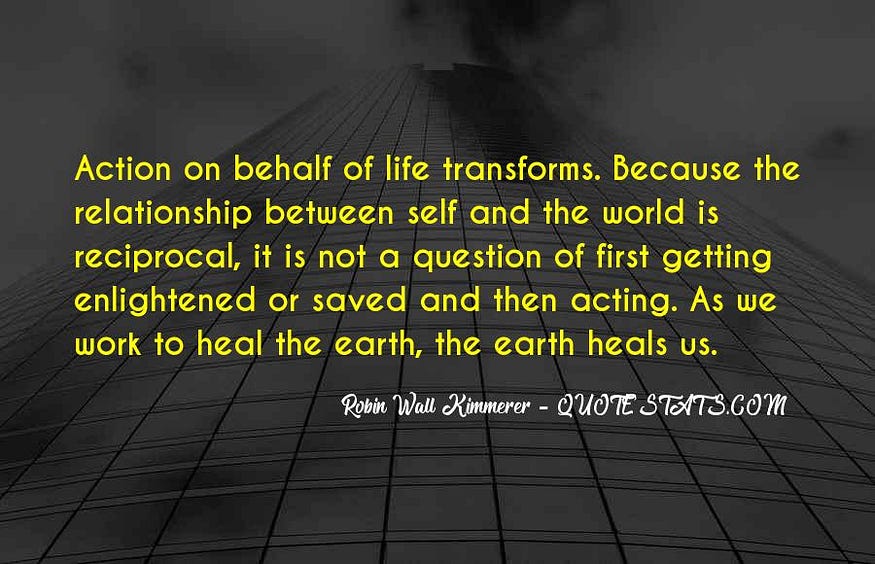
Our civilization’s evolution has been a spiral of emergence from one level of convergence and complexity to the next order of evolutionary complexity. And with each evolutionary step, the fundamental narratives have shifted. The shifting of narratives has led to cultural and paradigm shifts — in perceptions, worldviews, beliefs, values, and norms — that have always challenged the status quo, often drawing the wrath of the powerful and the privileged.
Darwinism and evolutionary biology challenged religious believers; Galileo’s heliocentrism (Earth revolving around the sun) and Copernicanism (Earth rotating around the sun) dismantled the belief that the earth was the center of the universe; Mahatma Gandhi’s non-violence movement as a strategy for social change shifted the trajectory of British imperialism in India. Thus, narratives are extremely powerful. They can make or break nations, countries, societies, and our planet.
What if the new narrative we co-create is founded on the bedrock of life-affirming values and actions?
In this liminal space between stories where one world is dying and the other is struggling to be born, lie the potential and power to reimagine and rejuvenate. The power to break away from the hegemony of universalism and co-create a new narrative that counteracts all that is noxious in our old story. A narrative founded on the principles of Interbeing, Pluriversality, and Abundance need to be told.
Stories create our worlds and worldviews. They help us to make meaning in a seemingly random and arbitrary universe. Without stories to lean into, we would not be able to cohere with intentionality and collective energy. Stories become the basis of cultures; thus, new narratives have the power to shift cultures, and cultural forces have the power to drive political and systemic changes.
For good or bad — narratives shape and give rise to norms, values, structures, and processes, which when repeated often enough become the culture — of nations, societies, communities, organizations, groups, or teams. After a point, the underlying narrative is forgotten, and the culture becomes “the way things are done here”. These then go on to create the bedrock of societies, polities, economies, and ethics.
Hence, if we hope to bring about transformative, paradigm shifting change, we must replace the old stories with new ones embodying the beliefs, values, norms, and ethics of a regenerative future. We must move away from narratives legitimizing extraction, exploitation, expropriation, ecocide, and racism to ones that are regenerative and life-affirming. It is not enough to just highlight what needs to change. It is essential to collectively co-create a narrative that embodies ‘a world where many worlds fit.’
It is also crucial to define what such a narrative CANNOT be before we can define what it will be:
1. It can’t be a single, universalized narrative.
2. It can’t be about human centrality and male supremacy.
3. It can’t be a decontextualized model of development imposed on all.
4. It can’t legitimize the vested interests of a few individuals and nations.
5. It can’t marginalize or delegitimize any cosmology and ontology.
The new narrative reifying a regenerative future must be:
1. Contextual and pluriversal, and yet profoundly global.
2. Based on the principles of ‘reparative futures.’
3. Centered on decolonizing the future and the imagination.
4. Focused on generativity and thrivability, not on infinite growth on a finite planet.
5. Founded on our inherent and indelible interconnectedness with the web of life.
~What narratives do we want to tell now that will allow us to hold space for and co-create a regenerative future?
~What will be the edifices and mainstays of these narratives?
~What kind of leaders do we need to become amplifiers and stewards of these narratives?
~What do we, as individuals and collectives, need to do to actualize and manifest the regenerative future, ‘a world that works for all’?
Article originally published here in The Age of Emergence
You can read the first two parts of the article here:
Reimagining a Regenerative Future – Part 1
Reimagining a Regenerative Future – Part 2
Sahana Chattopadhyay — speaker, writer, facilitator, and story-seeker. A scribe to an emerging era, trying to make sense from chaos and collapse, holding space for fearless dialogues, and catalyzing transformation towards a pluriversal planet. For more of her work: https://linktr.ee/sahana2802
PLEASE DONATE to help Network Weaver continue in it’s mission to offer free support and resources to networks worldwide.
Reimagining a Regenerative Future — Part 2
Scripting new stories, seeking the unseen, unheard, unknown, unacknowledged…
The end of the human race will be that it will eventually die of civilization.
~ Ralph Waldo Emerson
Emerson’s line couldn’t have been truer as we enter the third decade of the 21st century. The world is literally and metaphorically dying from ‘civilization’ and its ramifications. If we dig deeper, we can see that underlying the visible are stories — intangible, invisible, and pervasive; all the more powerful because of that. They are scaffoldings propping up entire civilizations. Hence, the stories we tell and live by have power beyond imagination to shape and direct civilizational trajectories. The stories become compasses encompassing our values, beliefs, norms, structures, policies, and practices. In short, entire worldviews are encapsulated in stories.
Shilo Shiv Suleman’s mural above, evocatively titled Belonging, made me wonder how many of us feel that we really belong to the world we inhabit. It also made me mull over the need for fearless depictions of our almost surreal realities. The creation of beauty is as much an act of defiance as it is an act of aesthetic power. These strange, somewhat disjointed musings led me to wonder how have we arrived at this juncture where we face imminent extinction of most species, acute loss of biodiversity, collapse of the known world, and an ever-yawning divide between the privileged handful and underprivileged billions. This led me to conclude that the stories we are driven by and which form the foundation of our civilization need to be thoroughly scrutinized, deconstructed, and rewoven.
The simultaneous collapse — ecological, economic, socio-political, cultural, and spiritual — of the past few decades culminating in the pandemic is a clear lesson for us to reimagine our foundational narratives. Maybe, it is time to ‘un-civilize’ our stories, time to unshackle them from the credos of an obsolete world order and the delusions of modernity and techno-fantasy. It is time to liberate our stories from the myth of progress, the myth of human centrality, and the myth of our separation from ‘nature.’ These myths are all the more dangerous and insidious because we have forgotten they are myths.
Our current narrative reflects the dominance of Eurocentric, Western worldviews with its accompanying ways of being, seeing, relating, and doing. This worldview — through centuries of imperialism and imposition — has marginalized and delegitimized all other ways of being on and relating with the planet. It has claimed the superiority of universalism by posing as ‘objective truth.’ This de-contextualization and de-placement of the Western narrative has blinded us to its specious origins (Eurocentric, white, male) and have made it a part of the ‘universal unconscious.’ Donna Haraway called it the ‘god trick.’
Only as we collectively grapple with the collapse of the ‘normal’ as we knew it in the wake of the pandemic, does the underlying narratives become visible. The veil of illusion is ripped off, and the papered-over brokenness beneath stands revealed. Once seen, it cannot be ignored as innocuous. Its edifices — feeding on inequality and power, commodification of nature, atomization of individuals, and polarization of the human species — have created a vastly unequal world in an abundant planet, leaving scarcity, poverty, and desperation in its wake — culminating in ecological disasters, existential crises, and misery for the most vulnerable millions. It is, therefore, time to untangle ourselves from the chains and tenets of neoliberalism, neo-colonialism, and capitalism that are still running the show. It is time to hospice the imposed universalization of an essentially narrow worldview ‘controlling’ a world that is unfathomably myriad, diverse, complex, interconnected, and alive: a wonderfully pluriversal planet.
After a quarter century of complacency, in which we were invited to believe in bubbles that would never burst, prices that would never fall, the end of history, the crude repackaging of the triumphalism of Conrad’s Victorian twilight — Hubris has been introduced to Nemesis. Now a familiar human story is being played out. It is the story of an empire corroding from within. It is the story of a people who believed, for a long time, that their actions did not have consequences. It is the story of how that people will cope with the crumbling of their own myth. It is our story.
~The Dark Mountain Manifesto
‘Un-civilizing’ Our stories
How do we step into and embody an essentially pluriversal planet in reimagining a regenerative future?
How do we co-create the new narratives honoring our myriad ways of being, seeing, sensing, and learning?
How do we liberate ourselves form the ‘dangers of a single story?’
The hubris of a single cosmology and its accompanying expressions of modernity — infinite growth on a finite planet, technocracy fast approaching techno-fantasy (techno-lunacy?), relegation of half the globe to obscurity and invisibility (acknowledging that global south exists everywhere), and profound separation from ‘nature’ — has brought our civilization to the edge of annihilation. The even greater conceit is, of course, the confidence in human capacity to control and coerce the universe to human whims. And this is only made possible by the seeming ordinariness and triviality of daily life where much stays the same from day to day, where the improbable seems far away. This disguises the fragility that lies just beneath the placid surface, torn apart with ease by a tornado, a wildfire, or a pandemic.
“Human civilization is an intensely fragile construction. It is built on little more than belief: belief in the rightness of its values; belief in the strength of its system of law and order; belief in its currency; above all, perhaps, belief in its future.” ~The Dark Mountain Manifesto
Now, the familiar story of a civilization corroding from within is playing out — a story of humanity’s Faustian bargain with the Universe, and its consequences. As we linger in this liminal space between stories where one world is dying and the other is yet to be born, we must slow down. “The crisis consists precisely in the fact that the old is dying but the new cannot be born; in this interregnum a great variety of morbid symptoms appear,” wrote Antonio Gramsci. The rise of ‘morbid symptoms’ are evident in the rise of authoritarianism, state surveillance, hyper-nationalism, and all forms of supremacy and oppression around the globe.
To counteract these mighty forces, we must slow down. We must shift from the superficial and outward busyness as a means of escape; we must stay with the trouble, befriend uncertainty, and listen to what the chaos is telling us. We need to move away from the lures of ‘civilization,’ from its known contours, and worn-out pathways. And then act from a place of humility, fierce compassion, and radical tenderness for all of Life. The journey towards a truly regenerative future has no known trails; the paths will be made by walking, being, and embodying our truths as individuals and collectives.
This is precisely what we are witnessing in the dispersed movements of dissent dotting the globe today — from #BlackLivesMatter to #FarmersProtes, from the #MeTooMovement to #FridaysfortheFuture. These are uprisings of ‘ordinary’ people in small, diverse pockets challenging the dominant and major narratives and politics. People going far beyond themselves and risking tyranny, torture, and arrest — students, farmers, activists, artists, writers, lawyers, journalists, housewives, environmentalists, ecologists, scientists, and every other ilk — coming together in defense of the planet, demanding a compassionate healing, demanding greater equality and transparency, demanding legal rights for the environment, and demanding fairer representation, and justice. These inchoate, self-organized, people-led movements are grass roots, pluriversal, and interconnected. Paul Hawken called this “the movement of movements.”
In these hidden voices lie the seeds for a regenerative future, an anti-fragile planet, the beauty of authenticity and wholeness. These voices eschew human supremacy and Western worldviews, reject the tricks and ploys of modernity with its promises of perpetual growth, and disregard ideas of separation from nature. These voices arising from the wilderness are literally ‘Gaia’ speaking on behalf of LIFE, demanding a civilizational story that is life-affirming and soul-nourishing. Humanity has been coerced and lulled into enduring and abiding by rather specious dogmas because other stories haven’t risen yet with a cohesive and binding force.
The rules of our world are laws, and they can be changed. Laws can restrict or they can enable. What matters is what they serve. Imagine a law that starts from first do no harm, that stops this dangerous game and takes us to a place of safety… Polly Higgins, 2015
I believe that the life-force of LIFE is way more powerful than anything humans can envisage. And life will reassert itself. Through us. Through the uprisings of pockets of humanity across the planet coming together in defense of all sentient life. Through the movement of movements. Beneath the apparent destruction lies the humus of rebirth to be composted with radical humility, candor, and fierce compassion. It is telling that ‘humus’ and ‘humility’ both come from the same root meaning ‘on the ground,’ inviting us to reimagine the future from a place of grounded-ness as we co-create narratives towards a regenerative future.
When we zoom out, we can see the overarching commonalities across these disparate and diverse pockets of resistance and dissent spread across continents. These grass roots movements are shifting the civilizational narrative and collective consciousness, hollowing out the dominant one, and crafting a radically distinct one — based not on any single ideology or dogma but values like love for the planet, inclusivity and compassion, equality and justice, on making the invisible visible, and bringing legitimacy to that which the mainstream has disregarded for centuries. However, what is missing is a cohesive and unified thread to hold the nascent and emergent narratives together.
These responsibilities are to be considered in the practices of storying the past, living the present, and weaving new futures. (GTDF)
Underneath the chaos lies an infinite and magical order, waiting for us to re-member, reclaim, and regenerate. The chaos is the Earth’s response to centuries of extraction, exploitation, and extermination of its sentient beings — human and more-than-human in the name of civilization. The typhoons and tornadoes, floods and fires, droughts and decay are her immune system collectively responding to threats. This apparent chaos conceals the beautiful underlying order that pervades all living systems, asking us to pause, sense, and listen; to weave vastly different narratives as we envision a more beautiful world our hearts know is possible.
However, liberating the stories from the dominant ideologies is going to be fraught with obstacles and impediments posed by those in power who will use all machinations of privilege, power, and propaganda to maintain the status quo as they immensely benefit from it. The current narrative cannot exist without extraction, exploitation, expropriation, dispossession, ecocide, and deprivation because it is in denial of five fundamental truths:
Denial of limits. The conceit of the current narrative lies in not accepting the limits of humanity and the planet. By seeking infinite growth on a finite planet, the story has catapulted us into decay and destruction.
Denial of nature. Nature is perceived as inert matter, something ‘out there’ to be plundered at will. Its value lies in being of service to the infinite growth of our civilization. This ultimate denial and separation have culminated in disaster.
Denial of other worldviews. The enforced invisibilization and delegitimization of all ways of being except for the dominant Western one has led to a world in crisis. A single cosmology cannot encompass or make sense of the unfathomable variety of this universe. We live in a pluriversal planet.
Denial of the humanity of all. By refusing to recognize and honor the humanity of all, the story has been effectively ‘weaponized’ to create a world of vast inequality, injustice, polarization, and exploitation.
Denial of our interconnectedness. The story works by insisting that we see ourselves as separate from each other and all sentient beings, by pitting humans against humans, and by denying our entanglement with a living, diverse, complex, and intelligent universe.
All of us are struggling together toward a time when the human spirit can find more room for itself in the societies we create. We are all participating in enlarging the spaces in which we together dwell, so that they might hold more of the greatness of each of us. ~Margaret Wheatley
Activating Exiled Capacities
Beyond ideologies and dogmas, which are really levers of oppression, lie the narratives of humanity — pluriversal, inter-related, contextual, and emergent. This evolutionary shift is already underway. The future exists in the present. The reimagining and envisioning of a different future are happening. Everywhere. In visible and invisible ways. In the fringes and margins. But no longer contained and confined to the peripheries; instead, spilling over into the heart of society, erupting like shoots of hope amidst forces of destruction and decay. Forcing us to see and acknowledge the unseen, unheard, untold, and unrecognized narratives that contradict the constructed reality of mainstream propaganda.
These movements are underscoring another shift — from one where civilizational edifice were constructed by a few (mostly European white men) and founded on Eurocentric worldviews to one where emerging stories are being co-created through grass roots movements, and dialogic, collaborative practices, are emergent, embodied, deeply contextual, and yet, profoundly global. These nascent narratives surpass the barriers of separation and integrates a fundamentally different worldview — one that is not confined by the particulars of place and time, and yet holds context as foundational to its emergence. It is both a synthesizing and decentralizing force — holding space for diversities within the whole. And thus, aligns perfectly with the principles of living systems.
Do we believe we are participating in a world that knows how to organize itself?
Do we believe that qualities of commitment, compassion, generosity, and creativity exist in everyone and can be evoked?
Can we embrace, what Keats described as ‘Negative Capability?’
It happens when we honor and welcome myriad different ways of being, seeing, sensing, and learning — those ways that have been for too long relegated to the peripheries of civilization, those ways that have been superseded by the enforcement of a homogenized way of perceiving and being in the world. It happens when those who can no longer abide by the current narrative come together to co-create and reimagine new stories. It happens when those stories consigned to the margins for centuries are pulled into the center, crashing through our defenses and willful blindness, their wisdom integrating and interweaving to form the tapestry of new narratives. It happens when we find the courage to go just beyond ourselves, befriend our emerging selves, let go off what no longer serves, and make life-affirming choices.
What needs to be done is to make these core characteristics of the new narratives visible, tangible, and widespread. We have to traverse “beyond ourselves,” as David Whyte poignantly said, to go where we must.
Just beyond
yourself.
It’s where
you need
to be.
Half a step
into
self-forgetting
and the rest
restored
by what
you’ll meet.
There is a road
always beckoning.
~David Whyte, Just Beyond Yourself
Article originally published here in The Age of Emergence
You can read the first part of the article here: Reimagining a Regenerative Future - Part 1
Sahana Chattopadhyay — speaker, writer, facilitator, and story-seeker. A scribe to an emerging era, trying to make sense from chaos and collapse, holding space for fearless dialogues, and catalyzing transformation towards a pluriversal planet. For more of her work: https://linktr.ee/sahana2802
PLEASE DONATE to help Network Weaver continue in it’s mission to offer free support and resources to networks worldwide.
Reimagining a Regenerative Future — Part 1
Navigating radical uncertainty with radical tenderness…

MATURITY is the ability to live fully and equally in multiple contexts; most especially, the ability, despite our grief and losses, to courageously inhabit the past, the present and the future all at once. The wisdom that comes from maturity is recognized through a disciplined refusal to choose between or isolate three powerful dynamics that form human identity: what has happened, what is happening now and what is about to occur.
~Anais Nin (quoted in brainpickings; italics mine)
Never has there been the need to inhabit multiple contexts more than now — “to courageously inhabit the past, the present and the future”. The start of 2020 presaged chaos, collapse, and terror. In January, the megafires of Australia. In February, megafloods. In March, a deadly pandemic. No respite! The machineries of the world has collapsed and laid bare their fractures and fissures in the face of Covid-19 highlighting the appalling inequality, failed governments, spurious economic policies, failing and flailing nation-states, the exploitation, extortion, and extraction that runs the economy, the dehumanization of humans, and utter disregard for this fragile and beautiful planet.
2021 began with vaccines, which could and should have brought nations together with humanity prevailing over all surface differences to face a global challenge. Instead this degenerated into “vaccine apartheid” with wealthy nations like the USA and Britain opposing India and South Africa’s bid to waive Covid-19 vaccine patents. Vaccine hoarding is another game being played: “… though rich nations represent just 14% of the world’s population, they have bought up 53% of the most promising vaccines so far.” Rich countries hoarding Covid vaccines, says People’s Vaccine Alliance. What could have been a defining moment of compassion, connection, and care in the civilizational narrative turned into repulsive power play, politics, profiteering, and a show of brute strength and shocking neocolonial racism.
The dual traps of neocolonialism and neoliberal capitalism blinded leaders and nations to the most crucial lesson that the pandemic taught us. The infallible truth of our inextricable interconnectedness and interdependence with all sentient beings and this Planet. We cannot survive, let alone thrive, as long as a vast majority of the planet remains oppressed, disregarded, and disavowed. “All the catastrophes we face now are byproducts of a feeble, decrepit industrial-capitalist economy. All that is what capitalism really is — exploitation of you, me, the planet, life on it, democracy, and the future, by organizations wealthier than countries, with legal superpowers, whose only goal is to maximize profit, at any cost. How are we to cohere, prosper, survive, endure — grow?” ~ Umair Haque. One would have thought that the pandemic must have driven this lesson home when a microscopic zoonotic virus jumped species and ravaged the world. Apparently not!
The pandemic, nonetheless, was a point of discontinuity — a rupture in the seams of the already fraying civilizational narrative of universal and never-ending growth and development, the utopia of technology as savior, and the myth of the West leading the rest of the world on an onward march of progress. There have been many moments of disruption, but none spanned the globe with such a visible and terrifying impact bringing mighty nation-states to their knees and halting the juggernaut of the ostensibly unstoppable machinery of global economy. This rift threw up with blinding clarity the brokenness that lay hidden just beneath the surfaces of society, politics, and other machineries and machinations of civilization. The simultaneous collapse of essential systems across the globe — from healthcare and economics to politics and education — are visible evidence of an obsolescing and degenerating civilizational narrative. The depravity and decadence underlying the world order revealed themselves in all their shame.
2020 became an inflection point in the trajectory of the Anthropocene catapulting us directly into the liminal space of radical uncertainty for which we had no script. A space without stories to anchor us, a space of incongruities and paradoxes, of death and decay — a seemingly yawning chasm of obscurity. We were left grappling to make sense. In this interregnum, the questions we ask are crucial acting as compasses in an essentially map-less territory of radical uncertainty.
What if we could navigate radical uncertainty with fierce compassion and radical tenderness — for ourselves, for each other, for all sentient beings, for this beautiful, fragile Planet?
What would those choices and decisions made from a place of fierce compassion look like?
How would we envision our collective future from a place of radical tenderness?
In a 2015 Manifesto called Radical Tenderness, Dani d’Emilia and Daniel B. Chávez writes: “radical tenderness is to not collapse in the face of our contradictions… is to have peripheral vision; to believe in what cannot be seen.” The words are hauntingly evocative, prophetic, and profound. The chaos and conflicts threatening us daily are overwhelming, and it is easy to sink into despair and a desperate yearning for some semblance of stability and certainty. The pandemic can be a portal towards a regenerative future inviting us to hospice what no longer works, and to midwife the new. If only we can “believe in what cannot be seen”.
How can we collectively hold space for the new shoots to emerge from the debris and decay of this collapsing world?
How can we be stewards of those narratives that have been disowned and denied for centuries — those unheard, unseen, unacknowledged ways of being, seeing, sensing, and knowing which can be our salvation towards a regenerative future?
We know in our guts that there is no going back to the “old normal” if we want to survive as a species on this Planet we call home. We can also feel the quiet, ephemeral presence of the more beautiful world our hearts know is possible. “Another world is not only possible, she is on her way. On a quiet day, I can hear her breathing,” wrote Arundhati Roy.
The hegemonic narrative of growth, development, and modernity imposed through the imperial project of colonization — Eurocentric and Western — has not only been running the show for centuries but has sterilized and homogenized all other ways of being and relating on this planet. Donna Haraway called it “playing the god trick”. Now this “god trick” has spectacularly failed as it must. The ineffectuality of this monocultural worldview in a diverse and pluricultural planet is starkly visible.
By excluding, delegitimizing, and disavowing myriad ways of being, seeing, learning, and knowing that did not subscribe or partake in the mainstream, hegemonic, civilizational narrative, we failed to make sense of an inconceivably diverse world. The arrogance of this primarily Western cosmology and ontology being the only meaning-making device available to humanity is astounding in its presumption.
The pandemic is clearly an inflection point. The breakdown of the old order and its edifices are asking us to slow down, to connect with our inner wisdom, to lean into this liminal space of uncertainty and ambiguity, to widen our peripheral vision, and listen to Earth’s invitation to co-create a thriving, flourishing Planet — “a world where many worlds fit”. And maybe, just maybe — we will catch a glimpse of the shoots of the possible futures amidst the debris and decay of the dying.
Let us slow down and listen to the unheard, unnoticed, unappreciated voices and narratives signaling to us from the peripheries, from the edges of “civilization”. Voices and stories that have for centuries been marginalized, demonized, invisibilized — the oppressed, brutalized, and systematically persecuted voices of the human and the more-than-human. The sidelining was part of the project of colonization resulting in immeasurable loss, disconnection, and untethering for millions in the Global South. Global South is not a geographical location but a metaphorical identity that enfolds the unseen and the unheard, the disowned and the disavowed, the delegitimized, invisibilized, and demonized billions. Global South exists in the peripheries and margins everywhere. We become aware of them in movements like #BlackLivesMatter, #IndiaFarmersProtest, and many other local movements of dissidence and resistance that fly under the radar, are never reported, often brutally quelled — in short, effectively and methodically made invisible.
Why is it crucial to integrate the unheard, unseen, unfamiliar narratives into the new civilizational narrative of a regenerative future?
What is the essence of a world that contains multitudes of narratives — a world where many worlds fit?
How do we reimagine a regenerative future — a world where many worlds fit?
What are the founding principles and values of a Pluriverse?
When we acknowledge with humility that we can never know it all — that our knowledge will always be situated, contextual, and partial stemming from the land and its culture can we step into the emergent space of radical uncertainty with hope and humility. What we can do is listen with fierce compassion and co-create containers for fearless dialogues of possibilities.
Dialogues offer us opportunities to intertwine and interweave the myriad ways of being, seeing, and knowing. And dialogues also save us from the dangers of a single story. Dialogues offer us spaces for co-sensing and listening to each other.
~TEDx, The Story of the Global South
In the next part of the post, I explore the concepts of Pluriverse, and why is this necessary to shift the civilizational meta-narrative to one that is inclusive, compassionate, pluri-cultural, and regenerative. None of us have the answer, but we can collectively re-imagine a regenerative future by coming together in fearless dialogues — dialogues revolving around our hurts, our hopes, and our healings.
Article originally published here in The Age of Emergence
Sahana Chattopadhyay —Sahana Chattopadhyay is a global Speaker, Writer, Master Facilitator, Organization Development Consultant, and Coach. She works at the intersection of Complexity, Human Potential, Organizational Transformation, Systems Thinking, and Emergence. Her passion is to enable organizations to develop the capacities, skills, and mindsets to become “thrivable” in the face of uncertainty and ambiguityr, writer, facilitator, and story-seeker. (https://linktr.ee/sahana2802)
I am a part of the Possible Futures collective. I deeply acknowledge the many fearless dialogues here that have helped me shape my thoughts and birthed new ones.

PLEASE DONATE to help Network Weaver continue in it’s mission to offer free support and resources to networks worldwide.
From Learning to Doing
How do more of us help create a world that is good for all of us? Many of us have been attending at least a few of the hundreds of enticing webinars that have been available during the last pandemic year, but somehow have not been able to actually apply what we have learned in our communities.
The first challenge has been that most of these webinars are what I call “talking heads:” one individual or a panel of experts share new ideas with us for the entire session. At the end we may realize that we have a million questions and have no idea how we might proceed. But we immediately move back into our workflow and the memory of the webinar content quickly fades.
I’ve even been part of sessions that are more interactive, where we are put into breakout rooms after the presentation and have a chance to reflect on the information provided. But somehow this, too, is not quite enough.
As a result, I thought about times when I , or people I knew, had actually managed to apply a new idea to their community. The very crude chart (would love some graphics assistance on this!) below shows that there are many small steps that need to be taken (and supported by capacity builders) for learning to move to doing.
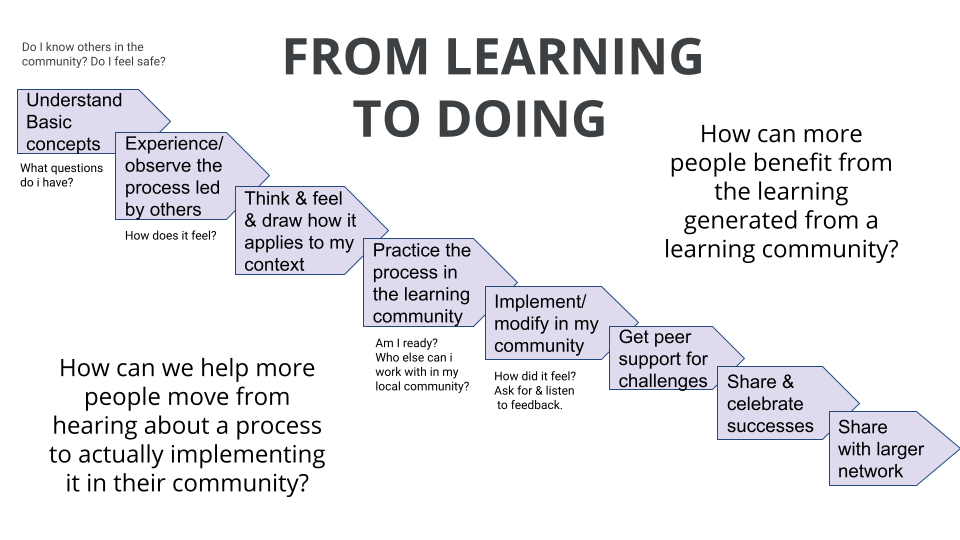
Let’s go through the steps:
Create a learning community.
First, I think learning communities are the best place to be introduced to new ideas. A learning community is simply a group of people (using zoom such groups could actually be very large if good use is made of breakout rooms) who commit to meeting regularly (usually monthly) to support each other’s learning and doing. It’s wonderful if you can have skilled, paid facilitation of such a group but they work amazingly well with informal groups who share the facilitation role. Most learning communities have some sort of focus to their learning, i.e. they may be people who want to learn more about systems strategies or network weaving or food access.
An important part of successful learning communities is that people in them feel safe to share their concerns or challenges. This means that learning community facilitators will need to include relationship building activities in every session where people get to know each other more deeply.
Hear information about a new process, skill or strategy and have space to ask questions and reflect.
I have found that listening to something new is often overwhelming, so I recommend that presenters limit their talk to 10-15 increments. If the topic is complex, you might want to have two 10 minute presentations each followed by a breakout session of 5 minutes. People can generate questions during the breakouts that are captured on a jamboard or Miro board - and answered by the presenter(s) as they are written.
Do a demonstration.
It’s often very useful for presenters to demonstrate the new skill or process with an individual or small group, with the rest of the participants observing.
Practice in the learning community.
The next step is to actually practice the process in the learning community, or in some cases, you may want to set up a smaller popup session for practice.
Thinking/feeling about application.
It’s often useful, especially for introverts, to have some time by themselves processing their reaction to the process. Participants can be encouraged to notice how the process feels to them? Might it be a good fit with their community? Does the process seem hard or simple/ is it scary to think about doing something like this in their community? They can write notes or be encouraged to draw.
You might also give participants time to discuss potential application in a breakout room. Here they might answer questions such as, “How might this work in my community? Who else could work with me on implementing this process? Could I try it first with a small group of people? What is a meeting coming up where I could try this?
Participants then (if they plan to go ahead) make a commitment to try out the process or skill in the coming month.
Applying in your community.
Participants hopefully have worksheets etc to help them take the information back to their community. They also need to be encouraged to find one or two others to work with them on the application. An important part of their planning process needs to be thinking about how the process may need to be modified for their specific context.
An essential part of any process will be to allocate time for the groups’ reflection on the process.
Other worksheets can encourage the facilitation group to spend time after to reflect on the process: what worked well? What would we need to change? What challenges did we encounter that we didn’t expect?
Get peer support for challenges.
When the learning group next meets, ask if anyone experienced any challenges in applying the practice. If there are several, you might want to have each person with a challenge go into a breakout room with others to support them. Then share the peer assist process to help them think how to work with the challenge.
As facilitator, you will need to frame the request for challenges with the importance of seeing challenges as a way to deeper learning. This embracing of so called mistakes is a key part of the mindset shift we all need to make.
Celebrate successes and harvest to share with other networks.
Encourage one or two participants to share successes they had with the process - encourage them to share pictures to make their success come alive for others.
You may want to facilitate a knowledge harvesting process. Some people have had success using jamboard, Miro or a google doc where everyone can add what they learned from implementing the process, suggestions for changes or improvements, key factors for success and so forth. Encourage one or two participants to take this input and craft into a post or handout that can be shared by participants with all their networks and social media connections. They may want to include video snippets of the process or people sharing how useful it was.
Share with other networks.
If the learning community is part of a specific network with a communications ecosystem, encourage the information to be shared through newsletters and social media. You might also want to turn the information into a resource or handout, as we are doing with this blog post!
If there is a good response to the sharing of the information, you might want to set up a popup for others outside of the learning community on how to use the process in their settings.
Big Picture
What is this chart suggesting about training? It’s saying that if we want our training to lead to change in communities, we need to reconceptualize training to make it more interactive and supportive of all the steps that are needed to move from learning to doing. We will get so much more impact if we shift the emphasis from content (and this is very hard because we as teachers, presenters and experts almost always LOVE our content and feel people need to have access to every bit of it! You can still share a longer video or article with participants so they can dig in deeper) to an emphasis on support for application of new practices.
Next steps
I would love for people to comment on this article, add additional ideas, edit it - in other words, make it better! Please just click on this link and it will take you to a google doc where you can comment or edit. This blog post can be so much better with your thoughts added. Once we have collected and edited those new thoughts, I’ll revise this blog post.
I’d also love to hear how you share this post with others in your networks. Was it useful? Did you take any steps to shift your webinars so they are more interactive?
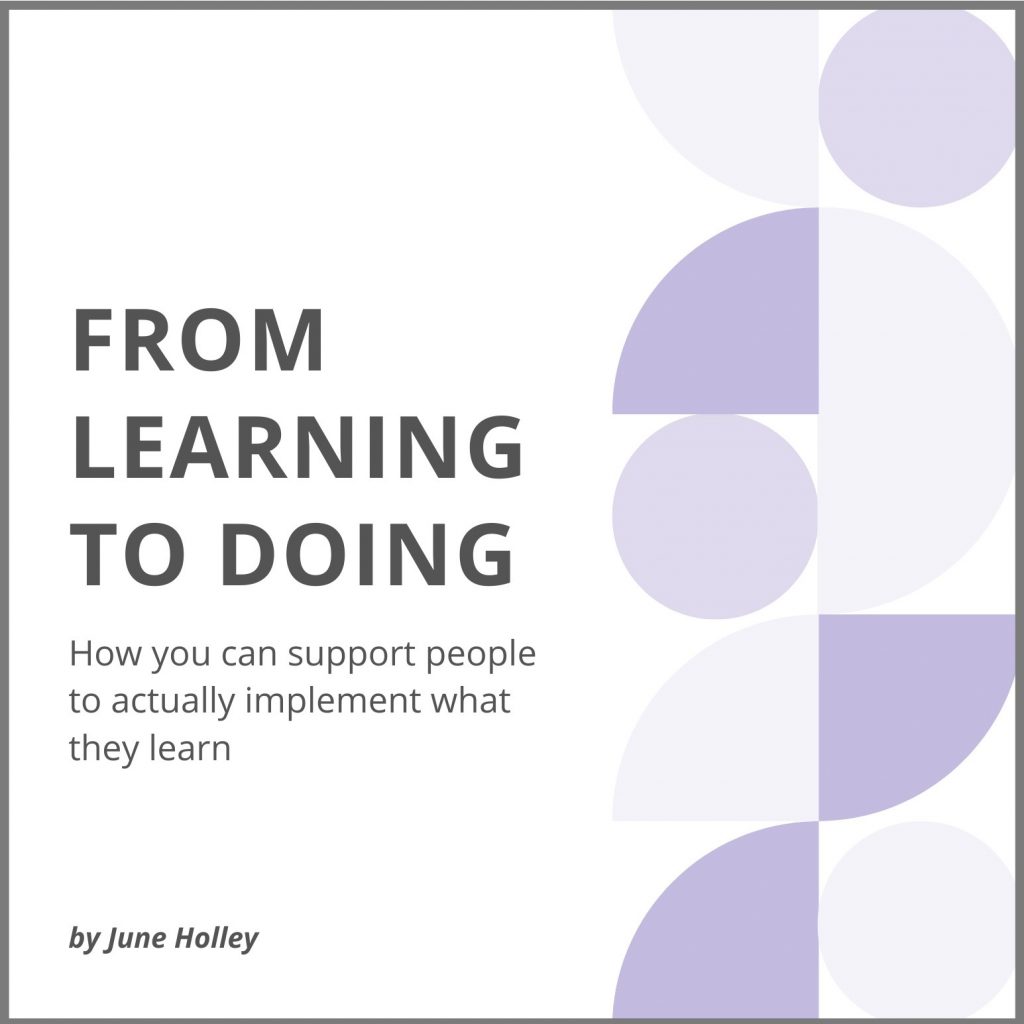
June Holley has been weaving networks, helping others weave networks and writing about networks for over 40 years. She is currently increasing her capacity to capture learning and innovations from the field and sharing what she discovers through blog posts, occasional virtual sessions and a forthcoming book.
featured image found here
PLEASE DONATE to help Network Weaver continue in it’s mission to offer free support and resources to networks worldwide.
A Poetic Ecology of Networks: Moving From “It” and “So That” to “Us” and “As”
Networks are fundamental to life, to liveliness and to livelihood. There is growing recognition of this fact. And at the same time, the frame through which one views networks has a lot to say about how one might be living out and into their potential, or not. For example, I still see people a bit enamored of “social network analysis” (SNA) in a way that concerns. It is the equivalent of pinning an insect to a board and dissecting it. The vitality of any living creature does not lie in understanding its “parts” alone, and pinning anything down does not allow “the observer” to see it in action, in its vitality. This is not to say that SNA cannot be helpful, but to keep in mind that anything frozen is not a true representation of life, and that the very observation of something changes it, as in living systems we are constantly engaged in the making “and bringing forth of worlds” through our interactions (see the work of the late Humberto Maturana) .
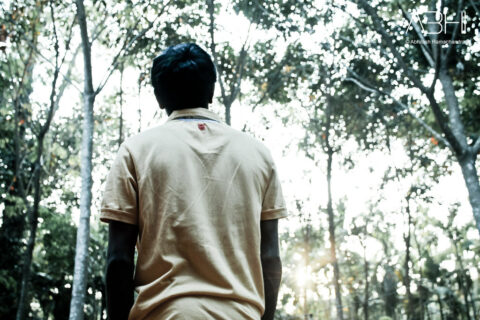
Which brings me to the use of “it” in referring to a network, or the idea of “building a network.” A network is not simply an it, it is an “us,” at least when we are referring to social and social-ecological webs. And a network is not simply a means to an end, a “so that,” if you will. Networks always “are” in some sense, in light of the myriad and often invisible connections that exist in our world. And as I have written before, the very nature of networks in terms of their patterns of connection and flow, has a lot to say about human and ecological health and resilience.
The use of “it,” which I certainly fall into, can create a degree of false and, in some cases, dangerous separation. A case could be made that much of what ails mainstream society and the human world is a severe case of distance and abstraction. As Andreas Weber has pointed out, this false separation in mainstream biological sciences can lead to the cutting off of something vital – our feelings and emotion! In The Biology of Wonder, Weber makes the case that far from being superfluous to the study of organisms (including social and and social-ecological networks), feelings (and I would add our bodies below the neck), are the very foundation of Life!
Which is why, increasingly, I am playing with full-bodied ways of engaging people in “network ways of thinking, doing and being” – at individual (internal to our selves – yes, we are networks!), group, and larger systemic scales. Whether it be poetry, music/song, meditation, storytelling, somatic practice, there is an apparent need to enlist people in a “poetic ecology” (in Weber’s words) of net work. This to me is key to helping to realize the regenerative potential of networks, and requires dedicated and deep practice.
What changes, what possibilities arise, when you shift towards “seeing” a given network as an “us” and an “as”?

originally published at IISC
Curtis Ogden is a Senior Associate at the Interaction Institute for Social Change (IISC). Much of his work entails consulting with multi-stakeholder networks to strengthen and transform food, education, public health, and economic systems at local, state, regional, and national levels. He has worked with networks to launch and evolve through various stages of development.
PLEASE DONATE to help Network Weaver continue in it’s mission to offer free support and resources to networks worldwide.


